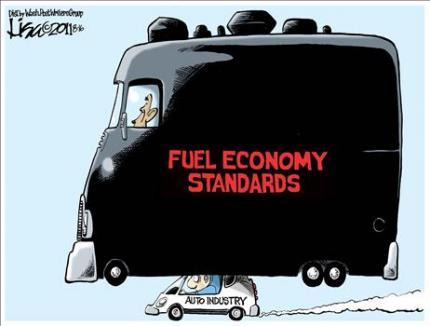My column posted at CNSNews.com.

Trump Fuel Economy Proposal Puts Brakes on Obama’s All-Pain-No-Gain Global Warming Crusade
By Steve Milloy
August 17, 2018, CNSNews.com
President Trump wants to get you into a new car of your choice for less money and sooner rather than later. To make that happen, his administration has just proposed to eliminate the pointless and expensive fuel economy standards for cars and light trucks issued by the Obama administration in 2012.
Pursuant to legislation passed during the now-over 1970s energy crisis, the Obama administration issued rules ordering carmakers to improve the average miles per gallon of their car fleets (called the Corporate Average Fuel Economy or “CAFE”) from about 27 miles per gallon (MPG) in 2012 to 50 MPG by the year 2025. The purpose of the new standards was to reduce fuel consumption and carbon dioxide emissions that supposedly contribute to climate change.
The problem, however, is that the carmakers have no magic technology on the drawing boards that would meet such tough standards. The only means for meeting the standards is to sell more low-profit electric vehicles and other small cars as opposed to the far more in-demand and highly profitable SUVs, pick-up trucks and crossover vehicles.
The carmakers acquiesced to the Obama rule in 2012 because they had just been bailed out of the 2008-2009 financial crisis by the Obama administration and, at the time, no one could imagine a future Trump deregulatory juggernaut. Carmakers also felt that they could always negotiate with the government in the future for time to meet the standards in the event no feasible technology was developed.
The Trump National Highway Safety Traffic Administration (NHTSA) and the Environmental Protection Agency (EPA) are proposing to basically freeze the CAFE standards at what they will be in 2020 (about 37 MPG) for the next 10 years.
The proposal is estimated by the Trump NHTSA/EPA to save consumers about $2,300 per new car and also to save about 1,000 lives per year, based on consumers being able to afford newer and safer cars sooner and also because higher fuel costs will curb driving.
While the proposal is estimated to increase daily fuel consumption by two to three percent, the good news is that it is no longer the 1970s as we are awash in oil. The Energy Information Administration estimated that in 2019, the U.S. will be the world’s leading producer of oil, topping its 1970 peak of 9.6 million barrels per day by 2.2 million barrels.
Though more gasoline would be burned, the Trump EPA estimates that it will make precious little difference to climate (for those who fret about that). If implemented, the proposal is estimated to increase atmospheric carbon dioxide levels from 789.11 parts per million (under the Obama standards) to 789.76 parts per million by the year 2100 — an 0.08 percent difference. That difference in carbon dioxide level translates into an estimated temperature difference of about 0.003 degrees Celsius — a difference that is not even detectable. The proposal will also have no detectable impact on U.S. air quality.
An important part of the Trump proposal removes California’s ability to be the de facto fuel economy standard setter for the nation, a role Congress had intended for the federal government – not any one state.
When the Clean Air Act Amendments of 1970 were enacted, the federal government was empowered to give California waivers to set its own air quality standards because of special conditions that existed in California. In 2012, the Obama administration expanded these waivers to cover carbon dioxide emissions even though those emissions have nothing to do with air quality. Carbon dioxide is a colorless, odorless gas that is at the core heart of the climate controversy.
With the waiver but without congressional approval, California effectively became the fuel economy standard setter for the entire nation. Carmakers don’t want to make two lines of cars, one for California and another for other states. And as California is considering a mandate for electric vehicles-only in the not-too-distant future, it’s clear that California cannot be allowed to dictate such policy to the nation.
The Obama CAFE standards were also intended to help meet the future U.S. commitment to reduce greenhouse gases under the Paris Climate Agreement. But President Trump announced last year that the U.S. was pulling out of the Paris agreement.
The Trump proposal would replace the Obama standards’ all-pain-and-no-gain global warming crusade with greater consumer choice, cost savings, improved safety and constitutional government. Sign me up for a new Trump car.
Steve Milloy publishes JunkScience.com [1], was on the Trump EPA transition team, and is the author of “Scare Pollution: Why and How to Fix the EPA [2]” (Bench Press, 2016).